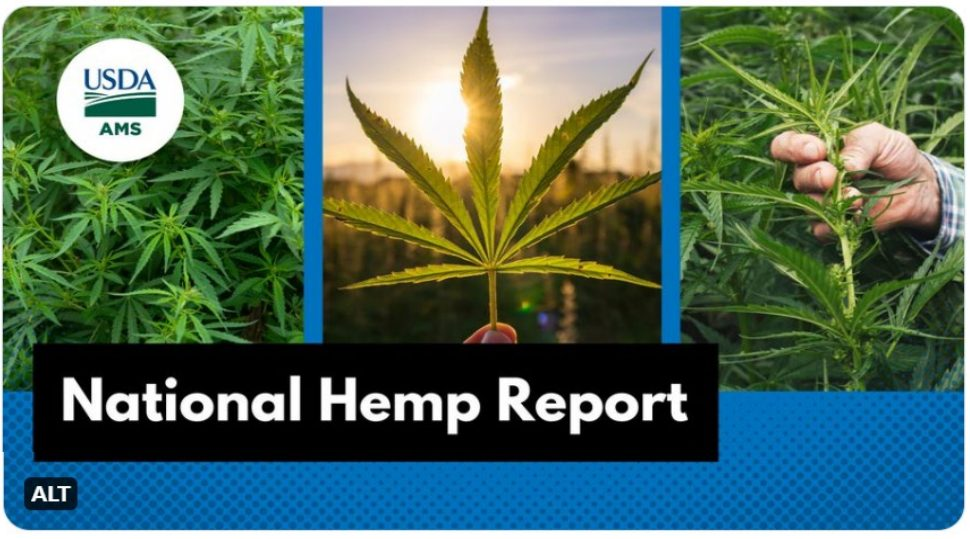According to the latest “National Hemp Report” released by the U.S. Department of Agriculture (USDA) , despite increasing efforts by states and some members of Congress to ban edible hemp products, the industry still experienced significant growth in 2024. In 2024, U.S. hemp cultivation reached 45,294 acres, a 64% increase from 2023, while the total market value surged by 40% to $445 million.
Industry experts noted that while this spike might suggest a recovery from the CBD market crash following the 2018 hemp legalization wave, the reality is far more complex—and less reassuring.
The data shows that hemp flower accounted for nearly all of the growth, primarily cultivated to produce unregulated intoxicating hemp-derived products. Meanwhile, fiber hemp and grain hemp remained in low-value sectors with declining prices, highlighting severe infrastructure gaps.
“We’re seeing a market divergence,” said Joseph Carringer, an industry analyst at Canna Markets Group. “On one hand, synthetic THC (like Delta-8) is booming, but this growth is short-lived and legally precarious. On the other hand, while fiber and grain hemp are theoretically sound, they still lack economic viability in practice.”
The USDA report paints a picture of a hemp economy increasingly reliant on **controversial cannabinoid conversion rather than “true hemp” (fiber and grain), even as states and lawmakers move to restrict synthetic cannabinoids.
Hemp Flower Continues to Drive the Industry
In 2024, hemp flower remained the industry’s economic engine. Farmers harvested 11,827 acres (up 60% from 7,383 acres in 2023), yielding 20.8 million pounds (a 159% increase from 8 million pounds in 2023). Despite the sharp rise in production, prices held firm, driving the total market value to $415 million (a 43% increase from $302 million in 2023).
Average yields also improved, rising from 1,088 lbs/acre in 2023 to 1,757 lbs/acre in 2024, indicating advancements in genetics, cultivation methods, or growing conditions.
Since the 2018 Farm Bill legalized hemp, farmers have primarily grown it for flower, which now accounts for 93% of total production. While hemp flower can be sold directly, it is mostly used for extraction to produce consumer cannabinoid products like CBD. However, its end use has increasingly shifted toward intoxicating derivatives like Delta-8 THC, synthesized in labs from CBD. A federal loophole has allowed these products to evade cannabis regulations—though this is rapidly closing as more states and lawmakers push back.
Fiber Hemp: Acreage Up 56%, But Prices Decline
In 2024, U.S. farmers harvested 18,855 acres of fiber hemp (up 56% from 12,106 acres in 2023), producing 60.4 million pounds of fiber (a 23% increase from 49.1 million pounds in 2023). However, average yields dropped sharply to 3,205 lbs/acre (down 21% from 4,053 lbs/acre in 2023), and prices continued to fall.
As a result, the total cash value of hemp fiber fell to $11.2 million (down 3% from $11.6 million in 2023). The disconnect between rising production and declining value reflects persistent weaknesses in processing capacity, supply chain maturity, and market pricing. Even with increased fiber output, the lack of robust infrastructure to utilize these raw materials limits their economic potential.
Grain Hemp: Small but Steady
Grain hemp saw modest growth in 2024. Farmers harvested 4,863 acres (up 22% from 3,986 acres in 2023), yielding 3.41 million pounds (a 10% increase from 3.11 million pounds in 2023). However, yields dropped to 702 lbs/acre (down from 779 lbs/acre in 2023), while prices remained stable.
Still, the total value of grain hemp rose 13% to $2.62 million, up from $2.31 million the previous year. While not a breakthrough, this represents a solid step forward for a category where the U.S. still lags behind Canadian imports.
Seed Production Sees Breakthrough Growth
Hemp grown for seeds saw the largest percentage increase in 2024. Farmers harvested 2,160 acres (up 61% from 1,344 acres in 2023), producing 697,000 pounds of seeds (down 7% from 751,000 pounds in 2023 due to yield drops from 559 lbs/acre to 323 lbs/acre).
Despite the decline in production, prices skyrocketed, driving the total value of seed hemp to $16.9 million—a 482% surge from $2.91 million in 2023. This strong performance reflects growing demand for specialized genetics and improved cultivars as the market matures.
Regulatory Uncertainty Looms
The report suggests that the future of the edible hemp market remains uncertain due to legislative pushback. Earlier this month, a Congressional committee held a hearing with the FDA, where a hemp industry expert warned that the proliferation of unregulated intoxicating hemp products is creating growing threats at both state and federal levels—leaving the U.S. hemp market “begging” for federal oversight.
Jonathan Miller of the U.S. Hemp Roundtable pointed to a potential legislative solution: a bipartisan bill introduced last year by Senator Ron Wyden (D-OR) that would establish a federal regulatory framework for hemp-derived cannabinoids. The bill would allow states to set their own rules for products like CBD while empowering the FDA to enforce safety standards.
The USDA first launched the National Hemp Report in 2021, conducting annual surveys and updating its questionnaire in 2022 to assess the economic health of the domestic hemp market.
Post time: Apr-28-2025





